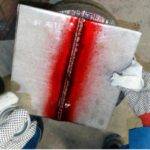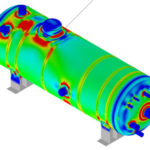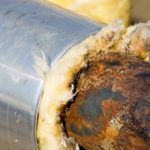Caustic Corrosion
If the salt concentrated under the deposit is having high pH due to concentration of caustic from TSP dosing, it start dissolution of protective magnetite (Fe3O4) layer on the evaporator tube wall inner surface and form sodium ferrite (NaFeO2) and sodium ferroate (Na2FeO2) as shown in the equation.
Fe3O4 + 4 NaOH ——-> NaFeO2 + Na2FeO2 + 2 H2O
ACIDIC CORROSION
Solution of low pH is generated in high pressure boilers in two different ways:
- pH of the entire boiler water is reduced when contaminants which are acidic or becomes acidic when heated in to the boiler.
- The bulk boiler water remains alkaline but acidic solutions are generated within corrosion pits by the action of dissolved oxygen and chloride. The most common acid forming contaminant is sea water or a river water which is low in carbonate and sulphate. In the boiler, the acidity is increased locally to corrosive concentrations by boiling.
In the acidic or highly alkaline conditions, iron reacts and hydrogen is liberated.
Fe + 2 NaOH = Na2FeO2 + H2
Fe + 2 HCl = FeCl2 + H2
If the hydrogen is liberated in an atomic form, it is capable of diffusing into the steel. Some of this diffused, atomic hydrogen will combine at metal grain boundaries or inclusions to produce molecular hydrogen, or it will react with iron carbides in the metal to produce methane.
Fe3C + 4 H = CH4 + 3 Fe
Because neither molecular hydrogen nor methane is capable of diffusing through the steel, these gases accumulate, primarily at grain boundaries. Eventually, the gas pressure created will cause separation of the metal at its grain boundaries, forming discontinuous, intergranular micro cracks as shown in the micrograph.
As these micro cracks accumulate, tube strength diminishes until stresses imposed by the internal pressure exceed the tensile strength of the remaining, intact metal. At this point a thick-walled, longitudinal burst may occur depending on the extent of hydrogen damage as shown in photographs below:
Photographs of 210 and 110 MW boilers, waterwall tubes show the failure due to hydrogen damage due to localised acidic condition.
IRC is regularly carrying out such studies to find out the reason of the failures and are also giving remedial actions to prevent it, if required we can also carry out chemical cleaning of boiler.
IRC is a service provider having expertise in ndt, residual life assessment, fitness for service, advanced ndt, failure investigation, chemical cleaning, certification of storage tanks as per chief controller of explosives guidelines , consultancy for boiler water chemistry and training
 IRC Engineering Services
IRC Engineering Services








Recent Comments